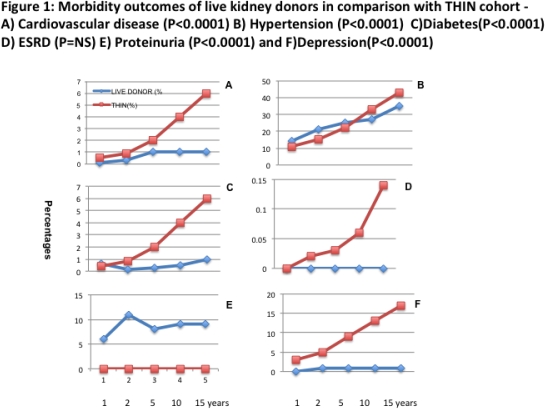Morbidity Outcomes in Live Kidney Donors in the UK: 15 Year Compartive Cohort Study
1Renal Unit, University Hospitals Coventry & Warwickshire NHS Trust, Coventry, United Kingdom
2Faculty of Health and Life Sciences, Coventry University, Coventry, United Kingdom
3Statistics and Clinical Studies, Organ Donation and Transplant, National Health Services Blood and Transplant, Bristol, United Kingdom
4Renal Unit, Queen Elizabeth Hospital, Birmingham, United Kingdom
5Renal Unit, Heart of England Hospitals, Birmingham, United Kingdom
6Academic Unit of Primary Care, University of Warwick, Coventry, United Kingdom
7Primary Care, West Midlands, Birmingham, United Kingdom
8Statistics, University Hospitals Coventry & Warwickshire NHS Trust, Coventry, United Kingdom.
Meeting: 2018 American Transplant Congress
Abstract number: 330
Session Information
Session Name: Concurrent Session: Kidney Living Donor: Long Term Outcomes
Session Type: Concurrent Session
Date: Monday, June 4, 2018
Session Time: 4:30pm-6:00pm
 Presentation Time: 4:30pm-4:42pm
Presentation Time: 4:30pm-4:42pm
Location: Room 6A
Understanding risks and long-term outcomes of live kidney donation is essential.
To investigate longer-term morbidity outcomes of live kidney donors (LD) compared to healthy controls.
Ethics approval was in place to accrue data. Protocol reviewed and passed by Renal Registry projects advisory group, and independent scientific review committee. Cohorts: A) LD: Dataset obtained from UK Transplant Registry, NHSBT, U.K. All LDs from January 1st 2001 to 31st December, 2013 included; end date 31st December 2016 . B) Comparative Cohort, The Health Improvement Network (THIN): This is large UK general practice database containing anonymized longitudinal patient records. Data from THIN collected stratified by age, gender, year of entry and excluding number of baseline conditions that would have been a contraindication to donation.
Figure shows significant increase in cardiovascular disease, diabetes and depression in the THIN cohort. Hypertension, though higher in the LD group initially, after seven years was significantly lower. No cases of ESRD in the LD group whereas 17 cases in THIN (P=0.01). Analysing eGFR <30, there were 8 cases in the LD group when compared to 94 in THIN (P<0.001).
Though hypertension was significantly more common in the LD group in the early years when compared with a healthy matched cohort, the prevalence of hypertension after about seven years was lower in the LD group. In this analyses live kidney donors seemed to have better long-term health outcomes than matched controls.
CITATION INFORMATION: Krishnan N., Mumford L., Lipkin G., Fletcher S., Dasgupta I., Gill P., Ryan R., Raymond N. Morbidity Outcomes in Live Kidney Donors in the UK: 15 Year Compartive Cohort Study Am J Transplant. 2017;17 (suppl 3).
To cite this abstract in AMA style:
Krishnan N, Mumford L, Lipkin G, Fletcher S, Dasgupta I, Gill P, Ryan R, Raymond N. Morbidity Outcomes in Live Kidney Donors in the UK: 15 Year Compartive Cohort Study [abstract]. https://atcmeetingabstracts.com/abstract/morbidity-outcomes-in-live-kidney-donors-in-the-uk-15-year-compartive-cohort-study/. Accessed December 15, 2025.« Back to 2018 American Transplant Congress

